Resource constraints are a common challenge in project management. It can be frustrating for the stakeholders and projects team to see a project stuck because of the lack of resources.
Yet, you can only wish for unlimited project resources.
Project managers must find a way to work around project constraints in project management to deliver on time and within budget. To do that, they must learn:
- What a resource constraint is
- Types and examples
- And how to identify and overcome these resource limitations
Ready to start managing resource constraints and getting projects unstuck?
Let’s dive in.
What are resource constraints in project management?
Resource constraints in project management are limitations on project resources—people, time, money, equipment, and materials—that affect a project’s success.
As a result, tasks get delayed, and sometimes, the entire project comes to a halt. This results in failure to complete the project within the estimated time and budget. Eventually, this results in project failure or at least a reduced return on investment.
Project management constraints are caused by:
- Unexpected events and emergencies
- Changes in project scope
- Limited availability of project resources within the organization or market
Effective project managers must be able to identify project constraints early in the project and develop strategies to mitigate their impact. Using the right resource planning tools helps.
Types and examples of project resource constraints
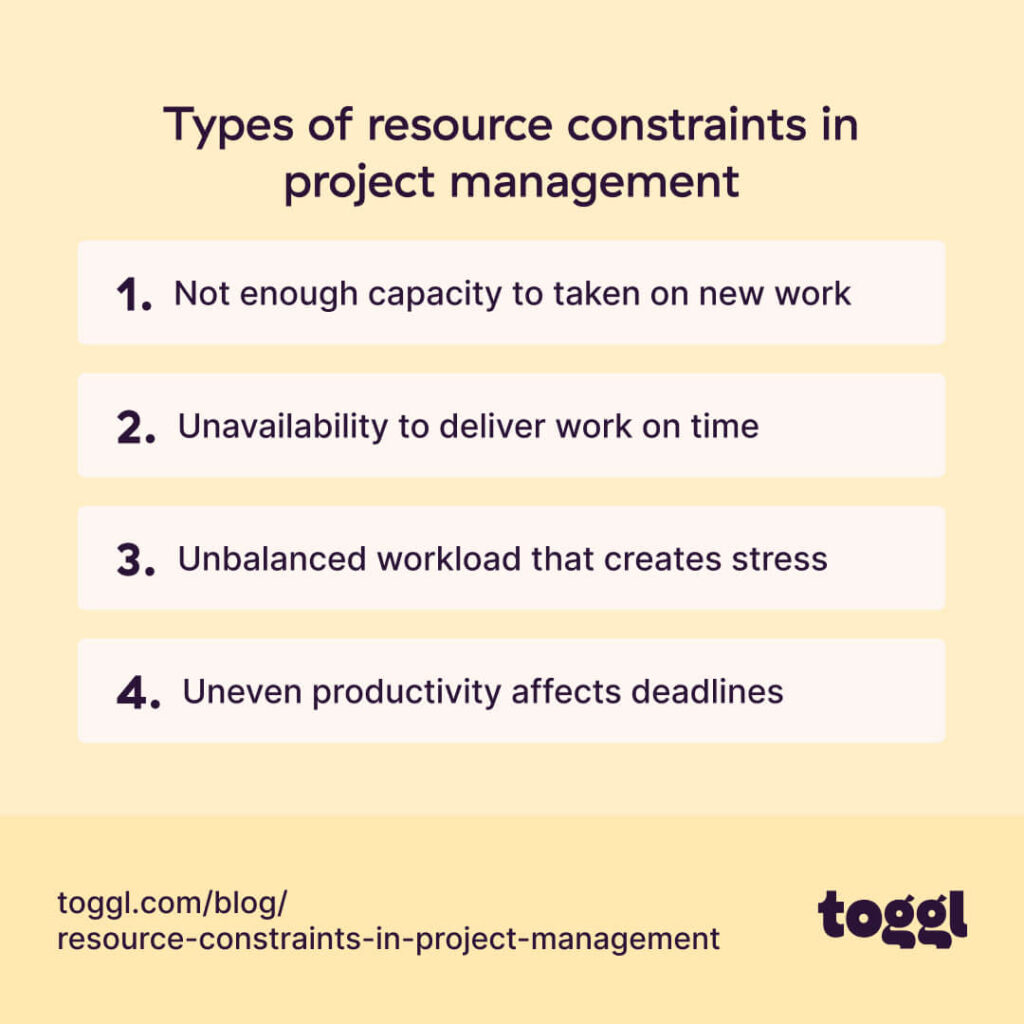
Resource constraints in project management are primarily of these four types:
Resource capacity constraints
Constrained capacity means your business doesn’t have enough people (or other project resources) to take on new projects. Taking on more work than your capacity results in delayed projects, poor quality, and unhappy stakeholders.
This is a common resource constraint in small businesses and startups.
You can overcome this project management constraint by increasing your capacity or taking on a limited number of projects. Hiring new team members and outsourcing parts of the projects are ways to increase capacity. In addition, some agencies and consultancies offer a pre-booking to limit their work.
Resource availability constraints
Limited availability means that you don’t have enough human (or other) resources available during the project period to ensure the timely completion of a project. Unplanned resource availability often leads to delayed projects.
Project managers often face this constraint during the holiday season.
The only way to overcome this resource constraint is with proper resource planning. This includes identifying the right project resources, planning resource allocation, and adjusting the project schedule to ensure resource availability throughout the project’s lifecycle.
Resource workload constraints
A typical workday is 8 hours. Sometimes your team needs to work less and, at other times, more. Not having enough workload leads to boredom and disengagement. On the other hand, overwork leads to stress and, eventually, burnout.
Workload constraints are a result of poor resource allocation.
Not having enough work is a byproduct of overallocation. Whereas overwork happens because of under allocation and poor project planning. Project managers must invest in optimal resource loading in the project planning phase and resource leveling/smoothing later to keep workloads under control.
Resource productivity constraints
You can manage the productivity of equipment and material resources. But human resources are an entirely different challenge. You can’t expect every team member to work at the same productivity levels. Nor can you expect the same person to work productively throughout the project duration.
Productivity constraints are caused by a variety of internal and external factors. Everything from the tools you use to an employee’s personal life can affect productivity.
Invest in time-tracking to monitor your team’s productivity. Identify what’s affecting it by directly talking to team members. And then provide solutions. Remember, the goal is not to spy on your team. But to ensure that your team can deliver the project without stress and burnout.
6 strategies to overcome resource constraints in project management
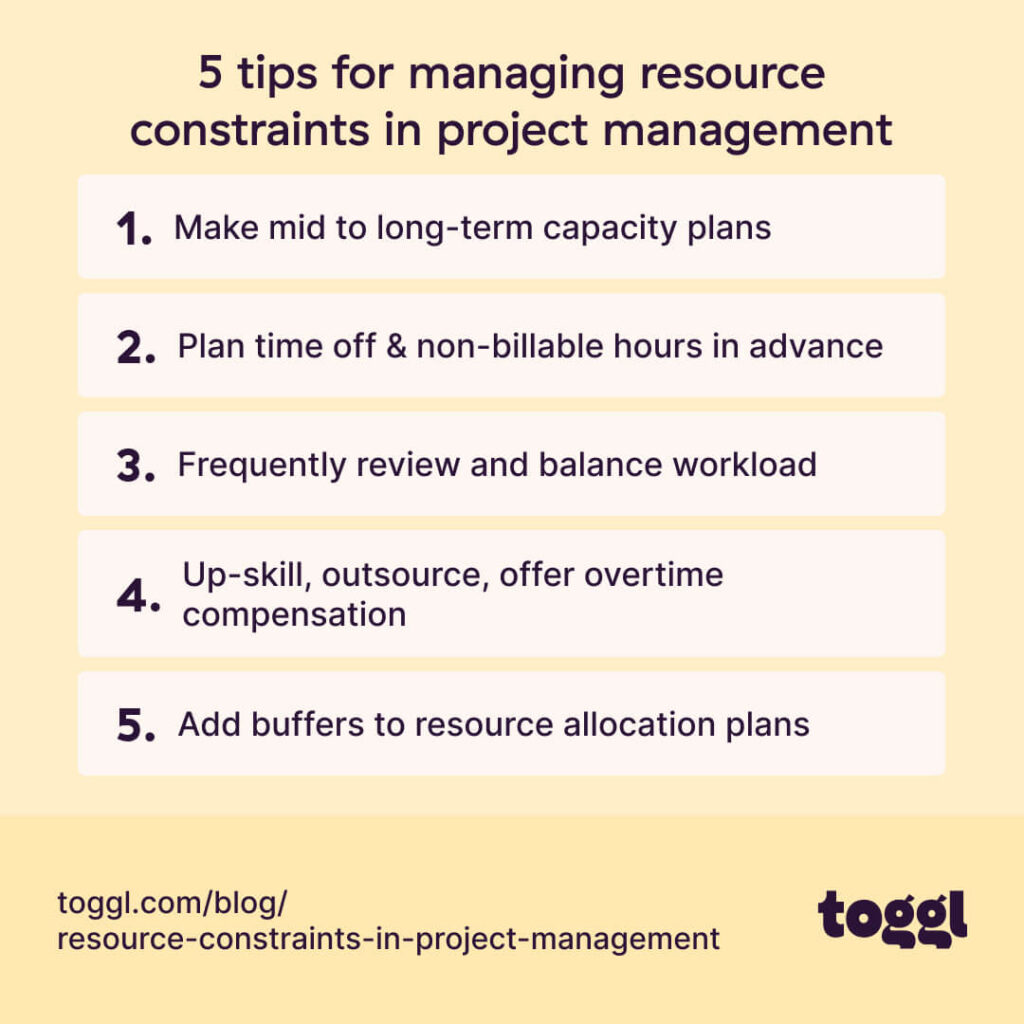
So far, you’ve learned about resource constraints and types, examples, and symptoms. Next, read about how to overcome these potential resource constraints.
1. Keep an eye on long-term capacity
Capacity planning ensures that your business has enough staff and other project resources to take on and deliver new projects within the given time constraints.
Reviewing your business’s capacity helps you predict potential resource constraints in advance. A visual resource management software like Toggl Plan shows your team’s capacity over the next month, quarter, or year.
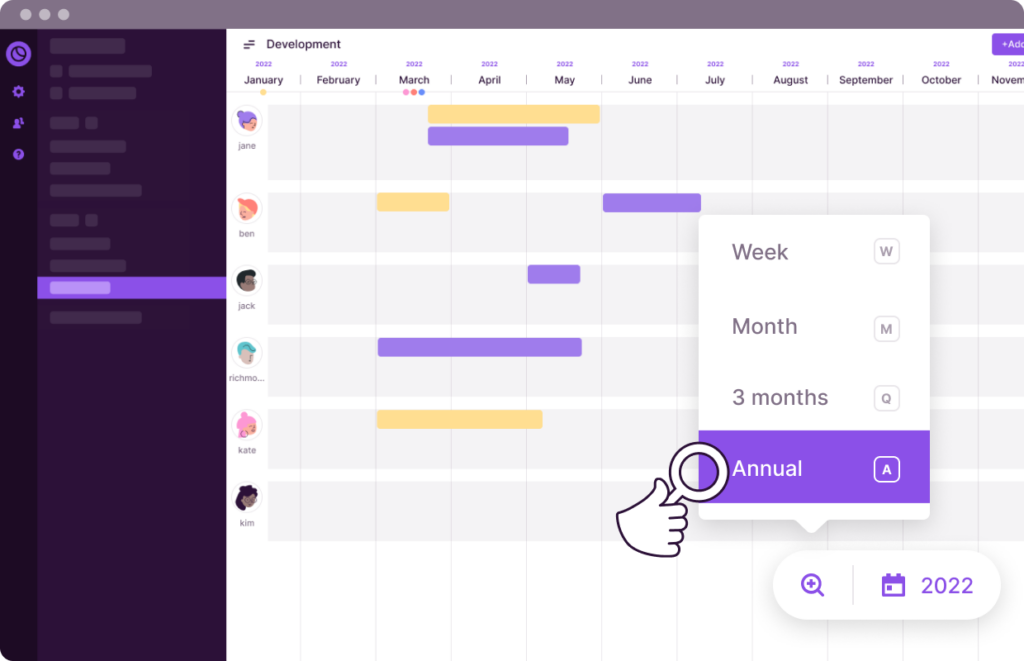
Of course, you can’t always predict everything in advance. But you can forecast demand and plan your capacity to meet it.
There are three ways to achieve optimal capacity planning:
- Keep your hiring plans in sync with forecasted work demand.
- Build strategic outsourcing relationships with freelancers and other partner businesses.
- Take on limited pre-booked projects.
2. Plan team availability in advance
While it’s impossible to predict your team’s availability in advance, it helps to plan availability in advance. There are three major availability constraints you can plan in advance. These are:
Other projects
Some team members work on multiple projects. For example, a graphic designer may work on multiple websites in a web design agency.
Talk to other project managers to understand how such shared resources are committed to other projects. Alternatively, you can use a tool like Toggl Plan, which makes it easy to look at a team member’s schedule across multiple projects.
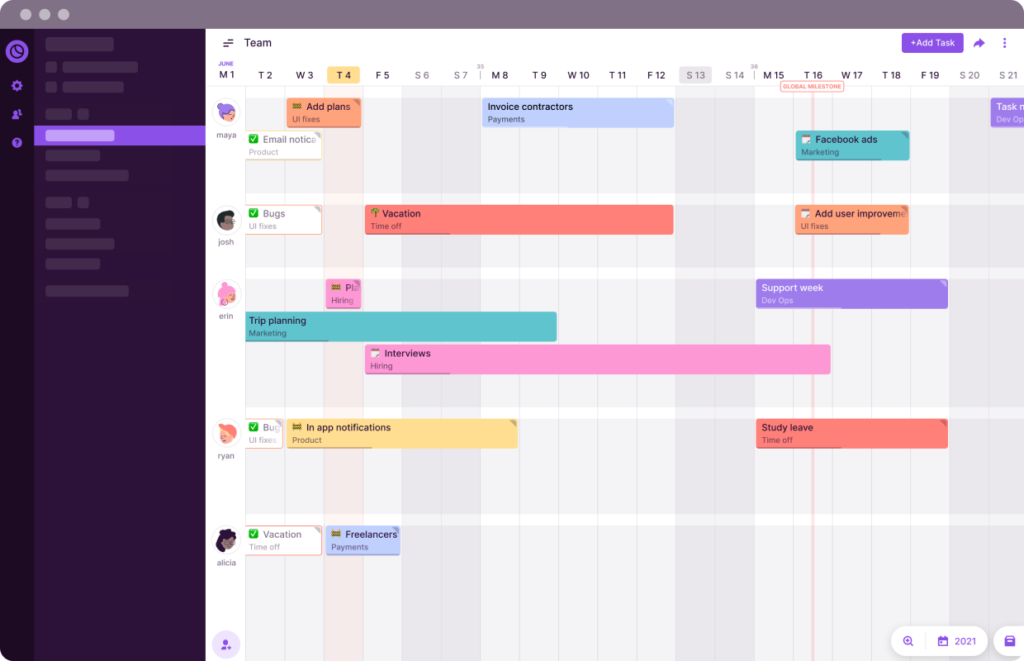
Time off
This includes both public holidays and vacations.
You can plan your team’s time off in advance by simply asking them about their plans over the outlook period. Depending on your business, the outlook period can be a month, a quarter, or a year.
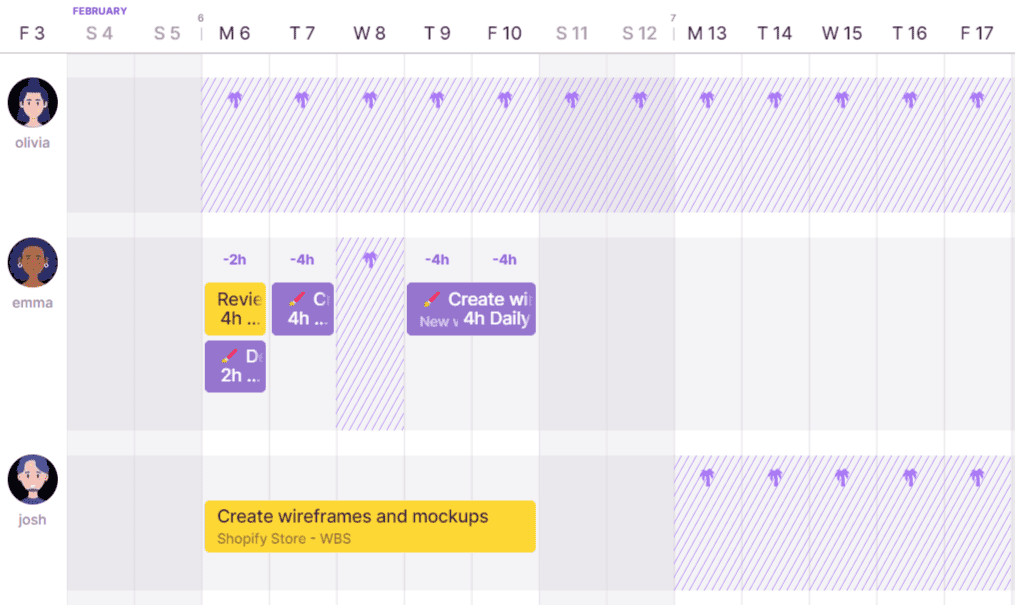
Planning your team’s time off plan helps you confidently handle resource constraints related to availability.
Non-billable work
Your team members don’t just work on client projects. Their time is also spent on internal meetings, training, off-site events, culture hours, and other admin work.
If you already know how your team’s time will be spent, it’s best to make it visible on your team’s schedule.
In summary, to allocate resources, you need clarity about their availability. Knowing when they are available (in advance) will allow you to work together far more easily and better manage resource constraints.
3. Frequently review and balance team workload
Project scopes change, and emergencies happen—To manage resource constraints effectively, you must monitor resource allocation constantly.
One way to do that is to look at your time-tracking tool to see how the workload is distributed among team members. Alternatively, you can conduct periodic 1:1 meetings with your team members and ask them about their workload.
There are two ways to resolve resource constraints due to heavy workloads.
Resource leveling
When the clients are flexible, a project manager can change the project management plan, including the start and end dates, to match resource availability. This is called “resource leveling”.
Changing the project deadline gives enough breathing room to the project team to overcome an unforeseen resource constraint.
Resource smoothing
When the project schedule is fixed, and the deadline cannot be changed, “resource smoothing” is applied. The project manager has no option but to bring in more hands. These could be employees within the company or temporary hires such as freelancers.
Unlike in resource leveling, where you adjust the project schedule, quickly finding new resources for a project can be expensive.
4. Find creative ways around resource constraints
One of the best things about a project is finding creative solutions to problems. You’ll need to do that occasionally to get around resource constraints. Here are a few ideas to get you started.
Invest in training and skill development
This helps your team members work productively. How? They’ll be able to accomplish their work more easily because they have the expertise to do it.
Upskill team members
Upskilling refers to providing current employees with additional skills. This helps develop more than one skill. As a result, you’re better placed to manage resource constraints.
Also, when employees receive professional help, they often feel more aligned with the company’s overall strategies and goals.
Offer overtime compensation
If you’ve planned correctly, overtime shouldn’t be a regular thing. But some team members may need to put in extra time at key milestones, near the end of a phase, or at the finish line.
Employees who’re in need will be more than willing to work the extra hours if compensated adequately.
Outsource
Outsourcing is a relatively quick option for managing constraints.
Creative agencies often work with freelancers and other agencies to get projects done. Another option is to look at recent ex-employees who’re looking for work.
However, you can start looking for outsourcing partners when you experience a resource crunch. It’s better to build a continuing relationship with freelancers and other partners long before you can give them work.
5. Add a buffer to your project time estimates
The project life cycle can throw up many situations outside your control.
Adding a buffer (aka lag time) provides a cushion before and after tasks to account for incorrect estimates and productivity constraints. Similarly, adding a buffer time when you allocate project resources allows you to hold on to resources if the project timeline changes.
According to this PMI paper, as uncertainty in task duration increases, the relative effectiveness of using resource buffers also increases
Resource constraints differ across projects. Hence there’s no standard buffer time. However, most project managers include a 10-15% buffer to ensure the timely completion of projects while dealing with uncertain resource demands.
6. Use time tracking for better project and task estimates
Finally, time tracking is critical. It allows you to monitor the time spent on projects and tasks. This helps you make informed decisions throughout the project’s lifecycle.
Time tracking comes with the following benefits:
- Improves productivity: allows project teams to identify non-productive activities and adjust their work processes to improve productivity.
- Accurate project estimation: provides more accurate estimates for future projects based on the past time spent on similar projects.
- Better resource allocation: Time tracking helps project teams identify which team members are spending too much or too little time on specific tasks, allowing for better resource allocation.
- Improved project management: Time tracking allows project managers to track progress more accurately and make better decisions about resource allocation, task assignment, and project timelines.
- Increased profitability: By improving productivity, accuracy, and efficiency, time tracking can help project teams increase profitability and reduce costs.
While some project management software offers time tracking features, only a time tracking app, such as Toggl Track, helps you gain insights into how your team’s time.
Level up your resource planning with Toggl Plan
Resource constraints are inevitable in project management when you’re working with limited resources. While you can’t anticipate every project constraint, you can adapt your resource management process to mitigate resource risks.
Excel resource planning templates can only take you so far. Use a visual project and resource planning tool such as Toggl Plan for more robust planning. It helps you plan projects, allocate resources, and track progress. Features include:
- Plan and adjust project schedules with drag-and-drop timelines.
- Get a clear overview of who’s doing what and when.
- Allocate available resources and balance team workload with simple drag-and-drop.
- Track time using a two-way Toggl Track integration.
- Track project progress with visual task boards and project Progress overview.
Ready to try Toggl Plan? Sign up for a free 14-day trial now.

Freya is an independent SEO consultant. She manages content marketing projects for top brands and helps them scale their organic traffic. She is a quoted contributor in several online publications, including Business Insider, Fox Business, Yahoo Finance, and the Huffington Post.


